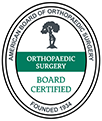Mako Partial And Total Knee Replacements
MAKO® is a novel surgical procedure performed to relieve pain caused by joint degeneration due to osteoarthritis. It is performed using the robotic-arm technology that allows the surgeon to precisely perform the surgery through a smaller incision as compared to traditional surgery.
Patients suffering from unicompartmental or bicompartmental knee disease may benefit from MAKO® partial knee resurfacing. Patients with osteoarthritis symptoms such as knee pain associated with activity, knee swelling, knee locking, and failure to respond to non-surgical treatment would be good candidates for the MAKO® procedure.
Your doctor may order a few X-rays and CT scan to determine the damaged areas, of the joint, that need to be removed for the precise placement of the knee implant.
During the MAKO® procedure, a four to six-inch incision is made over your knee with small incisions over your thigh bone (femur) and the shin bone (tibia). Only the diseased portion of your knee is removed, preserving the surrounding healthy bone and tissue. An implant is then secured over the prepared portion of your knee joint that results in resolution of symptoms and a natural knee movement.
Benefits
MAKO® offers the following benefits:
- Replaces only the arthritic portion of the joint
- More ideal joint function
- Accurate implant positioning
- Smaller incision
- Bone and tissue sparing
- Minimal hospitalization
- Rapid recovery
Since healthy bone is preserved, patients who undergo MAKO® may have a total knee replacement procedure later, if required. MAKO® is usually covered by health insurance. Your doctor will discuss the associated benefits and risks of the procedure.
MAKO® Partial Knee Resurfacing
Who would be a good candidate for the MAKO® procedure?
Although the best treatment for each patient must be determined individually, typical MAKO® patients share the following characteristics:
Knee pain with activity, on the inner knee, under the knee cap or the outer knee
Start-up knee pain or stiffness when activities are initiated from a sitting position
Failure to respond to non-surgical treatment such as rest, weight loss, physical therapy and non-steroidal anti-inflammatory medication.
Mako Total Knee Replacement
What is Mako Total Knee?
Mako Total Knee is the latest technology in total knee replacement which combines Stryker’s advanced robotic technology with its clinically proven GetAroundKnee (Triathlon Total Knee System) enabling surgeons to have a more predictable surgical experience with increased accuracy.
What is Mako Total Knee used for?
It is designed to relieve the pain caused by knee joint degeneration due to osteoarthritis providing patients with a personalized surgical experience based on their specific diagnosis and anatomy.
What are the advantages of Mako Total Knee?
- Superior implant design when compared to traditional knee implants that promotes natural circular motion requiring less muscular effort to flex the knee
- Precise pre-operative planning using virtual 3D model
- Accurate implant positioning using advanced robotic technology
- Quick recovery with faster return to activities of daily living
- Potentially longer lasting implant
How do you prepare for the surgery?
Prior to surgery, a CT scan of your knee joint will be performed that is used to generate a 3D virtual model of your unique knee anatomy. This virtual model is loaded into the Mako System software and is used by your surgeon to create your personalized pre-operative plan.
Does the Mako robotic-arm actually perform surgery?
No, the robotic-arm doesn’t perform surgery, nor can it make decisions on its own or move without the surgeon guiding it.
How is the surgery performed?
In the operating room, your surgeon will use the Mako System to assist in performing your surgery based on your personalized pre-operative plan. When the surgeon prepares the bone for the implant, the surgeon guides the robotic-arm within the pre-defined area and the Mako System helps the surgeon stay within the planned boundaries that were defined when the personalized pre-operative plan was created. The Mako System also allows your surgeon to make adjustments to your plan during surgery as needed.
What is the postoperative care required?
After surgery, your surgeon, nurses and physical therapists will set goals with you to get you back on the move. They will closely monitor your condition and progress. Your surgeon may review a post-operative x-ray of your new knee with you.
What are the risks associated with the procedure?
The Mako Total Knee procedure is a highly advanced and very safe procedure with more than 83,000 Mako hip and knee replacements performed around the world since 2007. However, as with any surgical procedure, there is a minimal risk of bleeding, infection, delayed healing or failure to heal.







